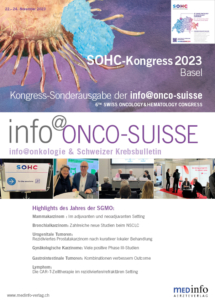Ihre Highlights am diesjährigen ESMO?
Richard Cathomas : Das absolute Highlight war natürlich die Präsentation der Resultate der EV-302/Keynote-A39 Studie (Powles et al., LBA6). Diese Studie wurde beim metastasierten Urothelkarzinom (mUC) durchgeführt und verglich die seit Jahren etablierte Erstlinien-Chemotherapie mit Platin/Gemcitabine gegenüber der Kombination des Antibody-drug Konjugats (ADC) Enfortumab vedotin (EV) und Pembrolizumab. Der primäre Endpunkt war das Gesamtüberleben (OS). Zum ersten Mal seit Jahrzehnten konnte eine Studie in der Erstlinientherapie des metastasierten Urothelkarzinoms einen signifikanten und klinisch sehr relevanten OS Benefit mit einer Verdopplung des Gesamtüberlebens zeigen (31.5 Monate mit EV/Pembro vs 16.1 Monate mit Platin/Gemcitabine ; HR 0.47). Hiermit ist ein neuer Standard definiert worden und die Prognose dieser Erkrankung hat sich massiv verbessert. Zu beachten sind speziellen Toxizitäten der Kombination mit EV/Pembro die ein vorausschauendes und proaktives Management benötigen.
Welche Resultate/Erkenntnisse haben Sie überrascht? Positiv oder negativ?
Im Bereich des metastasierten Prostatakarzioms wurden zwei grosse Phase 3 Studien präsentiert, in denen die Zugabe des PD-1 Inhibitors Prembrolizumab zur Standardtherapie geprüft wurde. Die Keynote-641 Studie (Graff et al., 1771MO) wurde bei Patienten mit metastasiertem kastrations-resistentem Prostatakarzinom (mCRPC) und die Keynote-991 (Gratzke et al., 1772MO) beim metastasierten hormon-sensitiven Prostatakarzinom (mHSPC) durchgeführt. In beiden Studien wurde Placebo-kontrolliert die Zugabe von Pembrolizumab zur standardmässigen Behandlung mittels Androgendeprivation und Enzalutamid untersucht. Leider zeigten beide Studien keinerlei Hinweise auf einen Benefit bezüglich des radiologischen Progressions-freien Überlebens (rPFS) oder des OS. Die einzige Indikation für eine Behandlung mittels Immuntherapie beim metastasierten Prostatakarzinom ist somit weiterhin das Vorliegen einer Mikrosatelliten-Instabilität (MSI high). Der Mikrosatellitenstatus sollte immer untersucht werden, eine MSI-high Situation liegt jedoch nur in 1-2% der Fälle vor.
Welche Erkenntnisse haben für Ihre tägliche Praxis eine grosse Bedeutung?
Neben der bereits eingangs erwähnten EV-302 Studie für das Urothelkarzinom ist beim Prostatakarzinom meines Erachtens die PSMAfore Studie (Sartor et al., LBA13) als practice changing einzustufen. In diese randomisierte Phase 3 Studie wurden Patienten mit progredientem mCRPC und vorgängiger Behandlung mit Androgendeprivation und einem ARPI (androgen receptor pathway inhibitor: Abiraterone, Enzalutamid, Apalutamid, Darolutamid) eingeschlossen. Verglichen wurde die Therapie mit dem Radionuklid 177Lu-PSMA-617 gegenüber einem ARPI-Switch. Beim primären Endpunkt zeigte sich eine Verdoppelung des rPFS (12.02 Monate vs 5.59 Monate, HR 0.43) mit 177Lu-PSMA-617. Beim OS konnte keine Verbesserung gezeigt werden jedoch erhielten 84% der Patienten im Kontrollarm aufgrund eines geplanten Crossovers auch die Therapie mit 177Lu-PSMA-617. Zu kritisieren ist die Wahl des Kontrollarms, da in dieser Situation eigentlich Docetaxel die Behandlung der Wahl darstellt. Jedoch sind viele Patienten und Ärzte aufgrund von erhöhter Toxizität gegenüber Docetaxel kritisch eingestellt und nicht alle Patienten sind in der Lage Docetaxel zu erhalten. Insgesamt stellt 177Lu-PSMA-617 meiner Meinung nach eine neue zusätzliche Therapiemöglichkeit beim mCRPC nach Versagen einer APRI-Behandlung dar.
Gibt es Fortschritte bei der Identifizierung von Biomarkern, die in der Zukunft prognostisch und prädiktiv verwendet werden können?
Am ESMO 2023 wurden mehrere positive Studien beim Urothelkarzinom mit dem FGFR Inhibitor Erdafitinib in verschiedenen Indikationen vorgestellt. FGFR hat sich definitiv als erster brauchbarer prädiktiver Biomarker beim Urothelkarzinom herausgestellt. Die Phase 3 Studie THOR beim mUC zeigte für Patienten mit FGFR-Alterationen eine signifikante Verbesserung des OS mit Erdafitinib gegenüber Chemotherapie (Siefker-Radtke et al., 2359O und Loriot et al., 2362MO). Da FGFR-Alterationen beim nicht-muskleinvasiven Blasenkarzinom gehäufter vorkommen, wurde Erdafitinib auch in dieser Indikation mit Erfolg geprüft (THOR-2, Catto et al., LBA102), jedoch ist die Toxizität bei systemischer Gabe hoch. Abhilfe schaffen könnte hier eine intravesikale lokale Applikation wie sie erstmals am ESMO gezeigt wurde (Device TAR-210, Vilaseca et al., LBA104). Solche lokalen zielgerichteten Therapien könnten beim Blasenkarzinom in Zukunft eine grosse Rolle spielen.
Welche Rolle spielen Liquid Biospsies und ctDNA in ihrem Bereich?
Beim Blasenkarzinom laufen bereits Studien zum Einsatz der ctDNA für die Therapiefindung in der adjuvanten Behandlung. Hier sind bald weitere Resultate zu erwarten.
Am ESMO 2023 wurden erstmals Resultate der ProBio Studie für Patineten mit mCRPC gezeigt. Dabei erfolgte bei Studieneinschluss eine ctDNA Analyse und basierend auf den Resultaten wurden die Patienten verschiedenen Behandlungen zugeführt (Grönberg et al., LBA86). Es handelt sich um eine sehr interessante Studie mit adaptivem Design. Die erste Analyse zeigte, dass basierend auf Mutationen im Bereich des Androgenrezeptors das Ansprechen auf verschiedene Therapien unterschiedlich ausfällt. Noch ist der Einsatz aber auf Studien begrenzt, eine Limitierung stellt sicher noch die Sensitivität dar : in der ProBio Studie konnte in fast 40% der Patienten keine ctDNA nachgewiesen worden obwohl nur metastasierte Patienten untersucht wurden.
Wie sehen Sie die Schweiz als Forschungsplatz am ESMO repräsentiert?
Auch dieses Jahr war die Schweiz sowohl mit SAKK Studien wie auch mit Studien aus verschiedenen Institutionen am ESMO wieder ingesamt gut vertreten. PD Dr. Michael Mark zeigte zusammen mit der SAKK eine Subgruppen-Analyse der SAKK 80/19 Studie (Mark et al., 2167P). Dabei konnte für Patienten mit Knochenmetastasen unter Immuntherapie kein Vorteil einer antiresorptiven Therapie auf das Auftreten von symptomatischen skelettalen Events (SSE) gefunden werden. Die Patienten mit Immuntherapie hatten zudem häufiger Kieferosteonekrosen. Der Einsatz von Antiresportiva muss in dieser Situation also gut bedacht sein. Die Abteilung Onkoloige/Hämatologie des Kantonsspitals Graubünden präsentierte die Resultate der « Hilotherapie-Studie » : bei Patienten unter Taxan-Chemotherapie wurde eine kontrollierte Kühlung der Hände und Füsse mittels eines Kühlgerätes durchgeführt. Als interne Kontrolle diente bei jedem Patienten die kontralaterale Extremität. Es konnte gezeigt werden, dass die Kühlung mit dem Hilotherapiegerät eine Reduktion der Taxan-induzierten peripheren Neuropathie bewirken kann (Johnson et al., 2104P).







